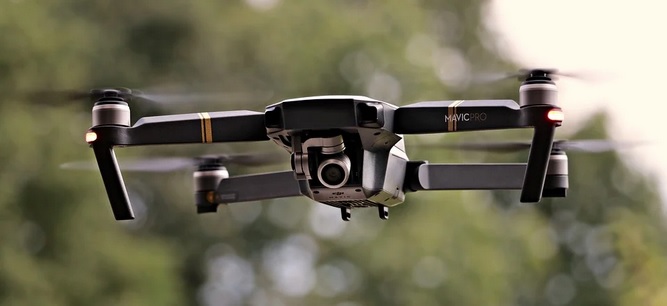Drones: remote-controlled technology

September 2, 2020
Today, drones are news in much of the world, both for their use in the scientific area as well as for war or humanitarian aid purposes. But many really don’t know what drones are.
Many people use these devices as a method of entertainment, but what they do not know is that drones are flying robots without crew, in many cases very advanced and are increasingly common in our society.
What is a drone?
The word “drone” has several different meanings, and originates from the ancient English word drān,drǣn, meaning “male bee”. When we talk about a drone as an electrical device, we’re thinking of a missile or a remote-controlled pilotless aircraft.
There are other names to define a drone, which can help us quickly identify what they consist of. Some are called quadcopters, sexacteros, or octacopters, depending on whether you have 4, 6 or 8 propellers. Therefore, we can define a drone as a vehicle that is controlled by remote control, which to rise uses the turning force of its engines attached to the propellers.
So what is a drone in the context of an unmanned aerial vehicle? One of the most commonly used definitions for the drone is: “A drone or ship that can sail autonomously, without human control or beyond the line of sight.” Another definition of frequent use is: “Drone is any drone or ship that is remotely guided.”
Drones in the military field
Drones are made of lightweight materials to reduce weight and increase maneuverability. In addition, the resistance of the material allows to fly at very high altitudes. They are usually equipped with Global Positioning Systems (GPS), military-type systems with state-of-the-art infrared cameras, lasers or guided missiles, and other top-secret systems. This is why a drone consists of the robot itself and the control system, which can be handled from ground or satellite, simply or with precision flight programs. Drones can fly at extremely high altitudes to avoid detection.
Drones with these characteristics are manufactured by companies in the military sector and specialists in the area, since they are mostly used in strategic government services that require them, for their high precision with which they are handled. They have carried out important tasks in preventing terrorist attacks. The most popular drones of this type are the MQ-9 Reaper and the Predator MQ-1B. These models are shaped like an airplane and have been developed by military powers such as England, Israel, Norway and especially the United States. These incredible flying robots are part of the present and future of the army of developed countries. Its use is called into question today by the United Nations (UN), the organization is very concerned that such systems may be violating human rights and other laws.
It should be remembered that a drone can not only be piloted by a human operator, but can fly autonomously following flight plans ordered through a software and following coordinate positioning systems such as GPS or GLONASS.
Applications and uses of drones
The development of these unmanned aerial vehicles has made millions of models available to users at affordable prices such as “geek” leisure. We must not forget that these aircraft are still unmanned aerial vehicles and are regulated by law, having to pay attention to such important premises as having accredited licenses, not flying in public open spaces and staying at a reasonable distance from airports, where their flight is totally prohibited, for the safety of passengers and their planes.
The main applications that we currently link to RPAs (Remote Piloted Aircraft System) come from the territory studio to obtain satellite images or digital elevation models. However, these small aircraft can do more for us and sometimes we don’t know their rare applications.
Forensic field
Drone technology has reached the forensic field. Thanks to the mapping of the flights carried out by our aircraft we can obtain images of an area where an accident or murder has occurred. By modeling the data we can recreate the scenario in 3D in order to reconstruct the facts and simulate what happened in a crime.
Health field
The health field has also been involved in the application of drones having developed devices equipped with semi-automatic defibrillators that can be sent to nearby places where a patient suffers a cardiorespiratory attack.
Disaster areas
Drones used for the control, handling and cleaning of polluting materials or areas devastated by tsunamis, earthquakes or fires, allows for faster access to inaccessible areas as well as the search for potential victims. Thanks to this, the territory can be evaluated, prior to its access, and the forms of access and preventive measures to be taken into account. In disasters such as those in Haiti, Nepal or Fukushima, this technology has been used, for example the use of the T-Hawk drone was crucial to obtain a detailed view of the state of the inside of the damaged reactor in Fukushima and to obtain photographs and other data with which to estimate the damage caused and thus develop a plan to clean up and contain future leaks.
Other areas
However, not all uses that can be given to a drone have to do with dangerous or industrial operations, since recently simpler models designed for the purpose of being marketed in areas more linked to recreation and free time such as photography, video, package delivery or augmented reality games and other social or sporting events have been introduced to the market , such as those used in the 2014 World Cup.
Types and classes of unmanned vehicles
Unmanned vehicles or simply drones can be aerial, ground or aquatic. In either case, these equipments are constantly evolving and their application has spread to the different fields of human knowledge, in sciences and engineering, especially the topic we address on precision agriculture. They can be classified from different perspectives: by use, by the type of control or by their shape.
As for the use we can find:
- Military drones: they are usually armed and capable of bombing, although other times they are only for espionage.
- Civilian drones: they are those that have no military use and in turn can be: drones for commercial use, for the sale of services such as photogrammetric, multimedia, etc. Drones for amateurs, for use as a hobby; government-used drones, for state forces, firefighters, rescue, etc.
By the type of control they use they can be:
- Autonomous: you don’t need a human pilot to control it from the ground. It is guided by its own integrated systems and sensors.
- Monitored: in this case you do need a human technician. The job of this person is to provide information and control the feedback of the drone. The drone runs its own flight plan and the technician, despite not being able to control the controls directly, can decide what action it will take. This system is common in precision agriculture and photogrammetric.
- Supervised: an operator pilots it, although it can perform some tasks autonomously.
- Preprogrammed: follow a pre-designed flight plan and there’s no way to modify it to accommodate possible changes.
- Remotely controlled (R/C): it is piloted directly by a technician using a console.
Advantages of drones
- Sports activities: these devices have already been flown over the playing field, managing to capture images from other angles.
- Photography, video and advertising: there are already drones designed for outdoor recreation experiences, managing to show fields and cities from other unusual perspectives.
- Air Control: it has become a tool of great help against fires or other catastrophes, as well as observing traffic, crops, surveillance, among others.
- Locate missing: with their thermal cameras they can detect the heat that living things give off.
- Reduce times: drones are used to make home deliveries, avoiding traffic and saving time in the delivery service.
- Reduce human risk: since you don’t need a pilot, no problem if you get to have an accident.
Disadvantages of drones
- Terrorist use: in fact its beginnings are presented when the military saw the possibility of its application.
- Short flight duration: drones usually travel a short distance in a short time, however, this aspect is improved every day.
- Invasion of Privacy: a drone can be sent to capture images or recordings of another person without your consent.
- Regulations: there is a regulation governing the flight of drones subject to the guidelines of each country.
- Low durability: it all depends on the capacity of your battery.
- You may have legal problems: this in case it falls and hurts a person.








